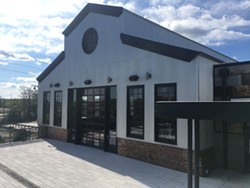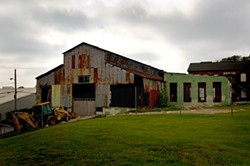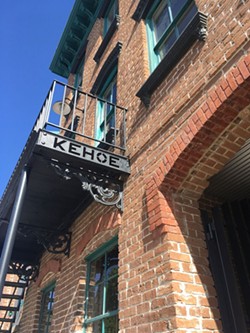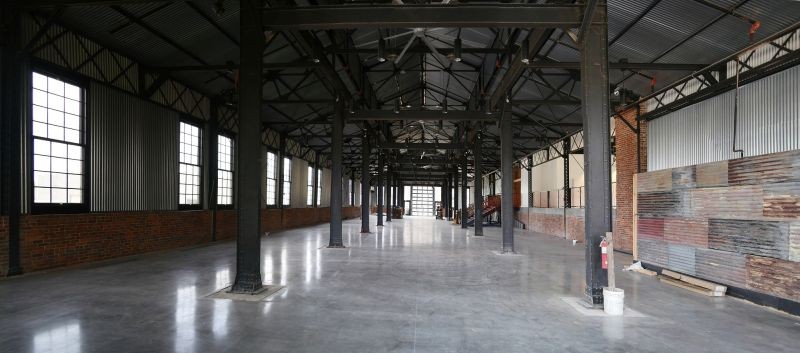IF YOU watched the new American Idol on ABC on March 25, you got a glimpse of the Kehoe Iron Works at Trustees' Garden, where that episode of Idol was filmed this past October.
The Kehoe Iron Works is not only one of the most far-ranging and ambitious historic and greenspace renovations in Savannah history, it’s an instant game-changer for local performing arts, culture, and quality of life.
The public will have its first chance to experience the new space in person at the all-day festival finale of the Savannah Music Festival on Saturday, April 14.
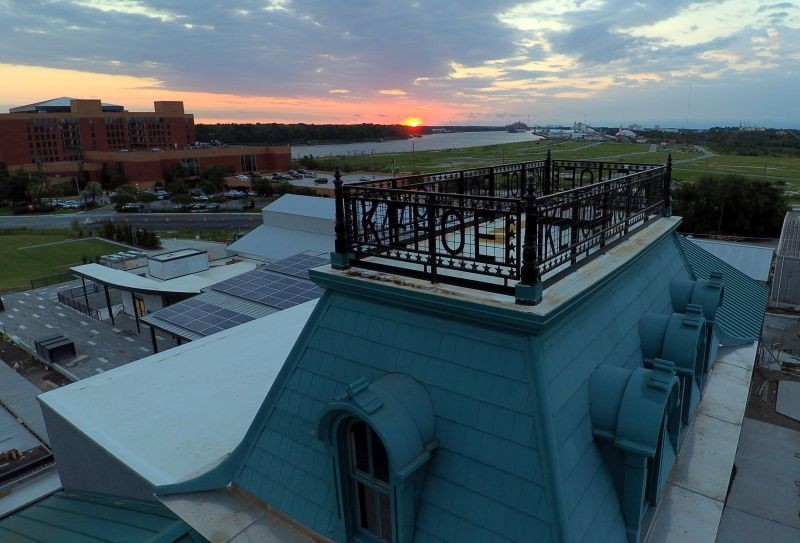
Developed by Charles H. Morris, locally-based owner of Morris Multimedia — which includes Connect Savannah — the Kehoe Iron Works project located at East Broad Street in the downtown historic district is the culmination of a four and a half year, multi-million dollar restoration and repurposing which is one of the premier such projects in the country.
“Savannah’s been really good to me, and to all of my family,” says Morris. “I want to give something back to this city. I’m a lucky man to live here.”
The historic site, once a vital and vibrant steel foundry started by William Kehoe in 1883, languished unused for nearly 30 years as a brownfield owned by Atlanta Gas Light.
In a series of purchases beginning in 2003, Morris garnered the entire nearly seven-acre Trustees’ Garden tract, the site of an early experimental garden planted by British colonists who arrived nearly three centuries ago with General James Oglethorpe.
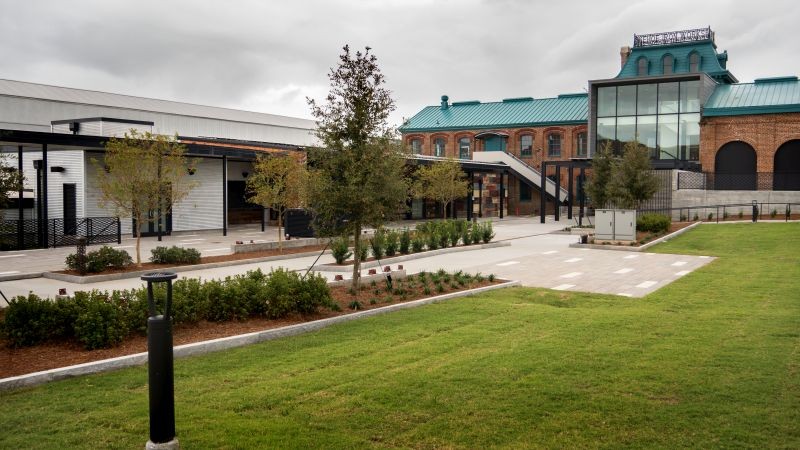
In person the restoration is stunning, both in scope and in quality, and far beyond what you may have seen on a television screen.
The most visible structure is the old Foundry itself, made of brick and incorporating an interesting “tower” of brick and glass. Adjacent to that is a spacious metal building, once the foundry’s machine shop. The only metal-clad building in Savannah’s Landmark Historic District and reportedly one of the last buildings in the world produced with Carnegie Steel, the machine shop is now restored as a meeting and performance venue.
There are several smaller structures and parking areas, all entwined within a vast scenic greenspace on a high bluff at Trustees’ Garden.
The nearby Morris Center adjacent to the Pirate’s House — a multi-use venue restored by Morris and opened in 2008 — is within easy view.
“Something Mr. Morris said about the project that rang true was that he really did want this to be Savannah’s living room,” says Jerry Lominack, principal partner with Lominack Kolman Smith Architects, the local firm tasked with the renovation.
“No one else would have undertaken this project on this scale and in this way,” Lominack says of Morris. “Ninety percent of people would have tackled it as another hotel or as condos.”
Morris’s inspiration for a multi-use indoor/outdoor space with great walkability and livable scale came from various educational trips abroad with his wife Rosalie.
“I had really been studying this in the context of European projects I’ve seen. I’ve also gone to Beijing to study things in China. The Chinese, throughout all the different leaders they’ve had for thousands of years, have done some really interesting things,” he says.
“We studied things like amphitheatres, and open areas. The Romans are probably the best of all — so much of what they built is still standing. You can still drive on their roads today,” Morris says.
Morris compares the Kehoe Iron Works to New York’s Rockefeller Center in the sense that “it’s a gathering place where people can go, and feels public, but is privately owned. The advantage to having something privately owned is it gives you more flexibility.”
Unlike many other concurrent high-profile projects in Savannah, Morris’s Kehoe project is privately funded, with no reliance on taxpayer money to move forward or be sustained.
While the Kehoe Iron Works project has expanded considerably from its original mission, one concept stayed intact from day one: Historic preservation.
“So much history kept revealing itself,” says Kevin F. Rose, lead architect on this project with Lominack Kolman Smith Architects.
“The real beauty is all there already. We’re just basically revealing it in a way that was not intrusive.”
Rose says he “fell in love” with these buildings way back in the late ‘80s when he first moved to Savannah, even in their then-decrepit state.
“Once you see the space for what it is now, you’ll see that it’s a gem. You can’t buy or build something like this nowadays,” he says.
This irreplaceable historic individuality goes down to the inch, and little effort was spared in maintaining a high level of respect for the original aspects of the structure.
“A lot of great craftsmanship goes into steelwork. For example, there’s basically one person in Michigan that still does this type of riveting,” says Rose.
“Though it’s more of an industrial site, there is a lot of brickwork. All the masonry has been completely repointed,” he says.
“And of course there are a lot of iron details. The interior columns are all original and were actually produced by Kehoe,” he says.
“You’re not allowed to use corrugated metal as a material in the Landmark District, but we were able to use it because that was the original material used,” Rose explains.
Lominack says “the concept started off initially as a non-airconditioned space in the metal building. We initially envisioned much more limited uses than what it’s ultimately ended up being. There was so much potential there.”
With “lots of differently scaled spaces indoors and outdoors, for all different size functions, the kinds of things that facility can accommodate is really vast,” says Lominack.
Because much of the success of the Kehoe Iron Works will be based on its use as a performance venue, the sound quality and capacity had to be top-notch.
Rose, who is also a professional sound engineer and recording studio owner, planned and executed the sound design of the entire project.
“I wanted Kevin to work on this because I know he is one of the best sound guys in town, plus he’s an architect,” says Morris. “I knew he’d understand what I wanted to do there.”
Rose says the big breakthrough is the decision to layer the ceiling to combine sound quality with historic accuracy, by putting specialized acoustic material behind the corrugated metal ceiling.
“It was important to me to match the aesthetic and the acoustic,” Rose says. “I wanted people to look up and see metal like you would originally. And there’s actually quite a bit of technology between the two slices of bread.”
Rose says “We took an approach that was the least intrusive, but also could let the building function and not be a giant echo chamber. It’s remarkable how it sounds in there.”
The end result, Rose says, “makes for a sound that’s just lively enough without being too lively. We worked speakers throughout the space, so there won’t be hot spots.”
Much of the work that has gone into the building, however, you won’t be able to see or hear.
“The insulation, the acoustics, the heating and cooling — all those items are hidden,” says Rose. “A lot of work, though, went into hiding it all.”
Because of the site’s construction, no wall outlets could be installed and still maintain historic integrity. All electric power and data/audio lines are in floor pockets.
Another key component of the site — and one you’re also unlikely to see — is the massive, state of the art kitchen, suitable for catering just about any size event likely to be seen in Savannah.
“There’s a full scale catering kitchen – which isn’t cheap, whether it’s commercial or residential. The big thing the kitchen has going for it, is so much of it is underground. It doesn’t obscure structures or sightlines. That in itself was a big move, and requires a very large elevator. In fact we have the largest commercial elevator you can buy,” says Rose.
But perhaps the biggest challenge — and the most hidden work — was involved with ensuring that the environmentally compromised site met all state and federal laws.
“There’s a lot of expense that went into the ground that a lot of people will never appreciate but was required,” says Lominack.
“A majority of people thought this site was just undevelopable. That it was too much of a challenge to tackle. The brownfield issues alone were very challenging,” Lominack says.
“There’s a lot of technology put into the ground over there. Some of it is monitoring a huge stormwater system that captures groundwater and delivers it to the appropriate City facility,” he says.
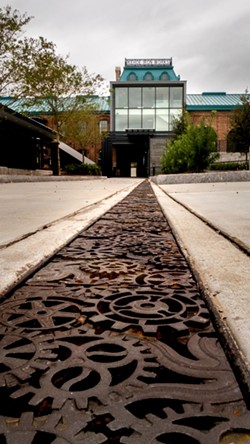
Still, Morris says he was under no illusions as to the Herculean efforts required in the Kehoe Iron Works project.
“When you’re doing any renovation, it’s like doing it two or three times,” he says. “If you start out with a clean piece of paper, a brand new building, you only have to do things one time. Here you’ve got to re-do and rebuild what’s already there.”
Morris says one day his wife Rosalie told him he now has the largest privately owned greenspace in the Savannah Historic District.
“I really hadn’t thought of it that way, but she’s right,” says Morris.
“If we can keep it like that, I want it to be enjoyed by multiple generations. I want children to be able to play there and have fun, and to have all kinds of events,” he says.
“At night it will probably morph into more of an adult experience, whether it’s a concert or a trade show. We will be expanding into the art world, doing events similar to Art Basel in Miami Beach. We’re studying all the different ways we can use the space, for art and education.”
Those who know Morris are aware of his abiding passion for health and wellness. His ongoing local partnership with the Arizona-based Canyon Ranch Institute is just one part of his belief in what he calls “the three most important words: quality of life.”
One of the underlying themes of the Kehoe Iron Works’ programming will be health and fitness education.
“I want to do expo-type things down there, bringing in health experts to educate the public,” Morris says.
As expansive as the project already is, this is just the first phase of what Morris calls a work in progress.
“We knew two things mattered to Mr. Morris,” remembers Lominack.
“One of course was leaving a lasting legacy — that’s really important to him. And the other is historic preservation. That was always his question with everything we proposed: What happened in this building originally and how do we plan to restore it? For him it all came back to history.”
The contrast of the deep care with which the Kehoe Iron Works site has been restored compared with some other recent development projects in Savannah can be glaring, to say the least.
It’s a subject of deep concern to Morris.
“I’m not anti-development. There are people in that community doing great work. But a lot of times, for example, they’re allowed to bump their projects up an extra story, and it seems like their request always gets approved,” he says.
“When some of these developers complain about the City, what some may be really complaining about is they want to push the limits and be allowed to build higher and uglier,” Morris notes.
“I’ve always loved restoration and historic things, and I really worry about this city in the context that some developers will come here and build unattractive multi-story buildings. I worry about the human scale and these big buildings,” he says.
“Every time I fly into Atlanta and look at all those skyscrapers, Five Points, Midtown, Buckhead. I don’t get why we’d want that in Savannah. The cities of the future may not be like that. They may be more healthy cities where people can walk and bike instead of having to get in the car all the time,” Morris says.
“We need people and organizations with a big picture grasp of what it takes to save this historic district from unimaginative developers,” Morris says.
“I hear people say that Savannah should be more like Charleston, or that Savannah should be more like Jacksonville, but Savannah has its own identity. We’ve got such an incredible city already, we don’t need to be going down the road of sprawl and out-of-scale buildings.”
Morris says he’s been struck with how the public has already received the Morris Center as well as the new Kehoe Iron Works, though many have still not experienced it in person.
“It’s amazing how many people I don’t even know who come up to me and thank me for restoring the Morris Center and Trustees’ Garden,” Morris says. “I can’t tell you how gratifying it is and how much joy it’s brought into my life.”

